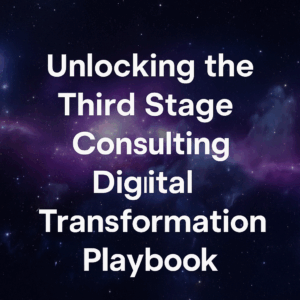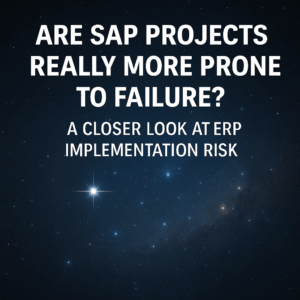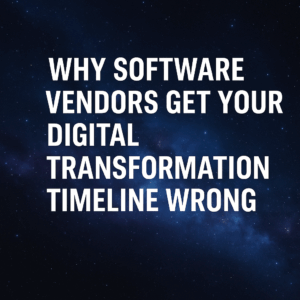It can be easy to get into trouble as you go through a software implementation. Whether it’s an ERP implementation or a CRM, HCM, supply chain management, business intelligence, or other technology you might be deploying, you will most likely face some speed bumps along the way.
Knowing how to handle these issues when they come your way is important, so here’s what you can do to recover your project and get back on track. I’ll also go over how you can ascertain what the root causes of your risks are, so you can deal with them before they turn into big problems.
#1 Proactively Mitigate Risk
The first way to resolve potential challenges or problems with your implementation is to avoid those challenges or problems in the first place – to the extent that you can. This is a lot easier said than done, but it helps to back up and look at what can you do to avoid issues, which comes down to program management, project governance, and overall risk mitigation and project controls.
If you can get the right governance and risk mitigation mechanisms in place, you’re more likely to identify risks before they become problems – and this itself is one of the key challenges with digital transformations, as oftentimes you don’t recognize that you’re getting into trouble until you see it and feel it. The problem with waiting until you feel the pain though is that it will probably be too late to fix anything. You need to really get ahead of the risks if you want to remediate them proactively.
Take a look at the below graphic, it shows the quality assurance framework we use with our clients to help identify and anticipate what the risks may be throughout the project. You can download it and use it as a reference for your own evaluation.

#2 Objectively Evaluate the Risks
Not all risks are created equally. You can’t expect to be able to mitigate and fully eliminate all risks that exist in a project, so don’t be overly optimistic and deny the fact that something can go sideways at any point in your project, even if you’re just starting out. Recognize what the risks are, prioritize them, and attack the ones that are most important and represent the biggest threat to the success of your transformation.
#3 Assess Root Causes
When we’re assessing risk in a project, we’re looking at symptoms of root cause issues. However, the key to risk mitigation is to attack the root causes rather than the symptoms. For example, many organizations find themselves over-customizing the software they’re deploying, but the problem is not over-customization itself, it’s the fact the organization might be avoiding change so is forcing the software to do things it wasn’t built to do. You should not ignore the customization issue, but focus more on getting after the root cause, which is the organization resisting change.
For each identified risk, you must proactively identify a root cause that can be attacked early on before it becomes a problem. Through expertise, objectivity, and a technology agnostic approach to implementation, you should be able to anticipate and understand what the issues are before they become symptoms later in the project.

#4 Understanding Common Risks
A common risk that we see in many transformations is unrealistic expectations regarding time, budget, and resources. Software vendors, system integrators, and sales representatives often create a false expectation of what it’s really going to take to get the job done, becoming one of the most powerful root causes of implementation challenges and failures.
Another common challenge is team misalignment. If as a team you don’t share the same vision of where you’re headed with the transformation, and the overall transformation doesn’t align with the corporate goals and objectives, it will not matter how great the technology is or how well you develop and deploy it. If you’re not aligned as an organization, you’re going to run into a lot of trouble.
Project governance and controls are also challenging. You must be in charge and in control of the project rather than assuming that your system integrator, internal resources, or your third-party consultants are going to manage risk for you and control the overall governance. This brings up a related challenge: transparency. You must have visibility into what your system integrator is doing and why they’re doing it. Not having that visibility is one of the reasons why many implementations go over budget and take longer than expected.
Last but certainly not least, there’s the risk of not having a proper organizational change management program in place. A lack of focus on organizational change management will typically lead to many challenges.
#5 Create a Recovery Plan
Once you’ve identified all the trouble points, make sure to create a recovery plan and clearly lay out what will you do to get the project out of trouble and back on track. Start with the stuff that has the biggest impact on the project, with the least amount of effort and disruption. Then, you work your way down the priority list to hopefully get to most of the risks that you’ve identified. It’s important to, in parallel, identify how you could get ahead of those risks, so you don’t find yourself in a constant remediation mode.

Any digital transformation project comes with its share of risks. But if you’re not proactive about managing those risks, you could find yourself in a costly, time-consuming, and frustrating loop. At Third Stage Consulting, we help our clients anticipate risks and understand them before they become a problem. Feel free to reach out to us for more information.
For best practices on how to make your transformation successful, you may download our digital transformation report. You will also find in it some guidance on how to manage organizational change management and an independent ranking of the top systems for different categories within enterprise technology.






